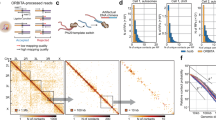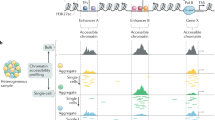Abstract
Chromatin is composed of DNA and a variety of modified histones and non-histone proteins, which have an impact on cell differentiation, gene regulation and other key cellular processes. Here we present a genome-wide chromatin landscape for Drosophila melanogaster based on eighteen histone modifications, summarized by nine prevalent combinatorial patterns. Integrative analysis with other data (non-histone chromatin proteins, DNase I hypersensitivity, GRO-Seq reads produced by engaged polymerase, short/long RNA products) reveals discrete characteristics of chromosomes, genes, regulatory elements and other functional domains. We find that active genes display distinct chromatin signatures that are correlated with disparate gene lengths, exon patterns, regulatory functions and genomic contexts. We also demonstrate a diversity of signatures among Polycomb targets that include a subset with paused polymerase. This systematic profiling and integrative analysis of chromatin signatures provides insights into how genomic elements are regulated, and will serve as a resource for future experimental investigations of genome structure and function.
This is a preview of subscription content, access via your institution
Access options
Subscribe to this journal
Receive 51 print issues and online access
$199.00 per year
only $3.90 per issue
Buy this article
- Purchase on Springer Link
- Instant access to full article PDF
Prices may be subject to local taxes which are calculated during checkout






Similar content being viewed by others
Accession codes
Change history
23 March 2011
Author initials were corrected for T.K.C.
References
modENCODE Identification of functional elements and regulatory circuits by Drosophila modENCODE. Science 10.1126/science.1198374. (in the press)
Gerstein, M. B. et al. Integrative analysis of the Caenorhabditis elegans genome by the modENCODE project. Science 10.1126/science.1196914. (in the press)
Adams, M. D. et al. The genome sequence of Drosophila melanogaster . Science 287, 2185–2195 (2000)
Clark, A. G. et al. Evolution of genes and genomes on the Drosophila phylogeny. Nature 450, 203–218 (2007)
Hoskins, R. A. et al. Sequence finishing and mapping of Drosophila melanogaster heterochromatin. Science 316, 1625–1628 (2007)
Tweedie, S. et al. FlyBase: enhancing Drosophila Gene Ontology annotations. Nucleic Acids Res. 37, D555–D559 (2009)
Felsenfeld, G. & Groudine, M. Controlling the double helix. Nature 421, 448–453 (2003)
Mendenhall, E. M. & Bernstein, B. E. Chromatin state maps: new technologies, new insights. Curr. Opin. Genet. Dev. 18, 109–115 (2008)
Egelhofer, T. A. et al. An assessment of histone-modification antibody quality. Nature Struct. Mol. Biol. 10.1038/nsmb.1972 (5 December 2010)
Eissenberg, J. C. & Reuter, G. Cellular mechanism for targeting heterochromatin formation in Drosophila . Int. Rev. Cell Mol. Biol. 273, 1–47 (2009)
Schwartz, Y. B. & Pirrotta, V. Polycomb complexes and epigenetic states. Curr. Opin. Cell Biol. 20, 266–273 (2008)
Li, B., Carey, M. & Workman, J. L. The role of chromatin during transcription. Cell 128, 707–719 (2007)
Liu, C. L. et al. Single-nucleosome mapping of histone modifications in S. cerevisiae . PLoS Biol. 3, e328 (2005)
Barski, A. et al. High-resolution profiling of histone methylations in the human genome. Cell 129, 823–837 (2007)
Larschan, E. et al. MSL complex is attracted to genes marked by H3K36 trimethylation using a sequence-independent mechanism. Mol. Cell 28, 121–133 (2007)
Riddle, N. C. et al. Plasticity in patterns of histone modifications and chromosomal proteins in Drosophila heterochromatin. Genome Res. 10.1101/gr.110098.110. (in the press)
Anders, S. Visualization of genomic data with the Hilbert curve. Bioinformatics 25, 1231–1235 (2009)
MacAlpine, D. M., Rodriguez, H. K. & Bell, S. P. Coordination of replication and transcription along a Drosophila chromosome. Genes Dev. 18, 3094–3105 (2004)
Blumenthal, A. B., Kriegstein, H. J. & Hogness, D. S. The units of DNA replication in Drosophila melanogaster chromosomes. Cold Spring Harb. Symp. Quant. Biol. 38, 205–223 (1974)
Ernst, J. & Kellis, M. Discovery and characterization of chromatin states for systematic annotation of the human genome. Nature Biotechnol. 28, 817–825 (2010)
Misulovin, Z. et al. Association of cohesin and Nipped-B with transcriptionally active regions of the Drosophila melanogaster genome. Chromosoma 117, 89–102 (2008)
Kagey, M. H. et al. Mediator and cohesin connect gene expression and chromatin architecture. Nature 467, 430–435 (2010)
Deal, R. B., Henikoff, J. G. & Henikoff, S. Genome-wide kinetics of nucleosome turnover determined by metabolic labeling of histones. Science 328, 1161–1164 (2010)
Henikoff, S., Henikoff, J. G., Sakai, A., Loeb, G. B. & Ahmad, K. Genome-wide profiling of salt fractions maps physical properties of chromatin. Genome Res. 19, 460–469 (2009)
MacAlpine, H. K., Gordan, R., Powell, S. K., Hartemink, A. J. & MacAlpine, D. M. Drosophila ORC localizes to open chromatin and marks sites of cohesin complex loading. Genome Res. 20, 201–211 (2010)
Visel, A. et al. ChIP-seq accurately predicts tissue-specific activity of enhancers. Nature 457, 854–858 (2009)
Zinzen, R. P., Girardot, C., Gagneur, J., Braun, M. & Furlong, E. E. Combinatorial binding predicts spatio-temporal cis-regulatory activity. Nature 462, 65–70 (2009)
Schwartz, Y. B. et al. Genome-wide analysis of Polycomb targets in Drosophila melanogaster . Nature Genet. 38, 700–705 (2006)
Schwartz, Y. B. et al. Alternative epigenetic chromatin states of Polycomb target genes. PLoS Genet. 6, e1000805 (2010)
Nechaev, S. et al. Global analysis of short RNAs reveals widespread promoter-proximal stalling and arrest of Pol II in Drosophila . Science 327, 335–338 (2010)
Core, L. J., Waterfall, J. J. & Lis, J. T. Nascent RNA sequencing reveals widespread pausing and divergent initiation at human promoters. Science 322, 1845–1848 (2008)
Wu, C. The 5′ ends of Drosophila heat shock genes in chromatin are hypersensitive to DNase I. Nature 286, 854–860 (1980)
Wu, C., Bingham, P. M., Livak, K. J., Holmgren, R. & Elgin, S. C. The chromatin structure of specific genes: I. Evidence for higher order domains of defined DNA sequence. Cell 16, 797–806 (1979)
Elgin, S. C. The formation and function of DNase I hypersensitive sites in the process of gene activation. J. Biol. Chem. 263, 19259–19262 (1988)
Jin, C. et al. H3.3/H2A.Z double variant-containing nucleosomes mark ‘nucleosome-free regions’ of active promoters and other regulatory regions. Nature Genet. 41, 941–945 (2009)
Hesselberth, J. R. et al. Global mapping of protein-DNA interactions in vivo by digital genomic footprinting. Nature Methods 6, 283–289 (2009)
Heintzman, N. D. et al. Histone modifications at human enhancers reflect global cell-type-specific gene expression. Nature 459, 108–112 (2009)
MacArthur, S. et al. Developmental roles of 21 Drosophila transcription factors are determined by quantitative differences in binding to an overlapping set of thousands of genomic regions. Genome Biol. 10, R80 (2009)
Kim, T. K. et al. Widespread transcription at neuronal activity-regulated enhancers. Nature 465, 182–187 (2010)
Filion, G. J. et al. Systematic protein location mapping reveals five principal chromatin types in Drosophila cells. Cell 143, 212–224 (2010)
Bernstein, B. E. et al. A bivalent chromatin structure marks key developmental genes in embryonic stem cells. Cell 125, 315–326 (2006)
Kanhere, A. et al. Short RNAs are transcribed from repressed polycomb target genes and interact with polycomb repressive complex-2. Mol. Cell 38, 675–688 (2010)
Schuettengruber, B. et al. Functional anatomy of polycomb and trithorax chromatin landscapes in Drosophila embryos. PLoS Biol. 7, e13 (2009)
Sekimata, M. et al. CCCTC-binding factor and the transcription factor T-bet orchestrate T helper 1 cell-specific structure and function at the interferon-γ locus. Immunity 31, 551–564 (2009)
Cherbas, L. et al. The transcriptional diversity of 25 Drosophila cell lines. Genome Res. 21 10.1101/gr.112961.110 (in the press)
Gravely, B. R. et al. The developmental transcriptome of Drosophila melanogaster . Nature 10.1038/nature09715 (this issue).
Clemens, J. C. et al. Use of double-stranded RNA interference in Drosophila cell lines to dissect signal transduction pathways. Proc. Natl Acad. Sci. USA 97, 6499–6503 (2000)
Acknowledgements
We thank our technicians D. Acevedo, S. Gadel, C. Kennedy, O.-K. Lee, S. Marchetti, S. Vong and M. Weaver, and Rutgers BRTC. We also thank our colleagues who donated antibodies: J. Kadonaga (H1), A. L. Greenleaf (RNA pol II), G. Reuter (SU(VAR)3-9), G. Cavalli (GAF) and I. F. Zhimulev/H. Saumweber (Chromator). The major support for this work came from the modENCODE grant U01HG004258 to G.H.K. (Principal Investigator) and S.C.R.E., M.I.K., P.J.P. and V.P. (co-Principal Investigators), administered under Department of Energy contract no. DE-AC02-05CH11231. Additional funding came from RC2 HG005639, U01 HG004279, R01 GM082798, R37 GM45744, RC1 HG005334, R01 GM071923, U54 HG004592 and NSF 0905968.
Author information
Authors and Affiliations
Contributions
P.V.K. performed most bioinformatic analysis. A.A.A., Y.B.S., A.M., N.C.R., E.L., A.A.G., T.G., D.L.-B., A.P. and G.S. generated data, directed by S.C.R.E., M.I.K., V.P. and G.H.K. The 30-state analysis was performed by J.E. and M.K., whereas M.Y.T., L.J.L., R.X., Y.L.J., R.W.P. and E.P.B. performed additional bioinformatic analysis. P.J.S., T.K.C., R.S., R.E.T. and J.A.S. generated and processed DHS data. D.M.M. helped with replication analysis. P.J.P. supervised all analysis. G.H.K. coordinated the entire project. P.V.K., G.H.K. and P.J.P. wrote the manuscript, with contributions from S.C.R.E., M.I.K., V.P., Y.B.S, N.C.R, A.A.A. and A.M.
Corresponding authors
Ethics declarations
Competing interests
The authors declare no competing financial interests.
Additional information
The data are available from the modENCODE site (http://www.modencode.org). GRO-Seq data are available from Gene Expression Omnibus (GEO, GSE25321).
Supplementary information
Supplementary Figures
This file contains Supplementary Figures 1-35 with legends. (PDF 27107 kb)
Supplementary Information
This file contains Supplementary Tables 1-6 and Supplementary Sections 1-2. (PDF 18112 kb)
Rights and permissions
About this article
Cite this article
Kharchenko, P., Alekseyenko, A., Schwartz, Y. et al. Comprehensive analysis of the chromatin landscape in Drosophila melanogaster. Nature 471, 480–485 (2011). https://doi.org/10.1038/nature09725
Received:
Accepted:
Published:
Issue Date:
DOI: https://doi.org/10.1038/nature09725
This article is cited by
-
ChromGene: gene-based modeling of epigenomic data
Genome Biology (2023)
-
The evolution and mutational robustness of chromatin accessibility in Drosophila
Genome Biology (2023)
-
Evolutionary adaptation of the Polycomb repressive complex 2
Epigenetics & Chromatin (2022)
-
Epigenetics of wheat–rust interaction: an update
Planta (2022)
-
Open chromatin analysis in Trypanosoma cruzi life forms highlights critical differences in genomic compartments and developmental regulation at tDNA loci
Epigenetics & Chromatin (2022)
Comments
By submitting a comment you agree to abide by our Terms and Community Guidelines. If you find something abusive or that does not comply with our terms or guidelines please flag it as inappropriate.



